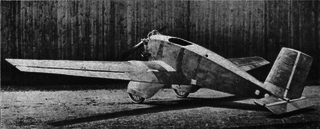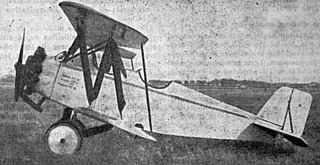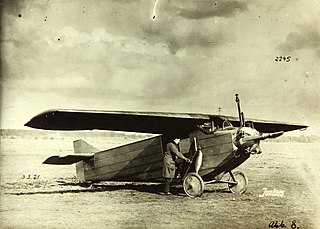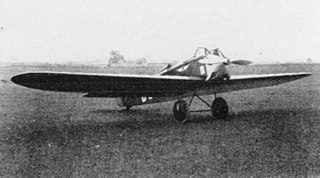Udet aircraft

| Industry | Aircraft manufacture |
|---|---|
| Founded | 1921 |
| Founder | Ernst Udet |
| Defunct | August 24, 1926 |
| Fate | Liquidated |
| Successor | Bayerische Flugzeugwerke |
| Headquarters | , Germany |
Udet Flugzeugbau GmbH was an aircraft manufacturer founded in the summer of 1921 in Munich by Ernst Udet with Henry Hans Herrmann and Erich Scheuermann, funded by the American financier William Pohl, designing and building light sport and commercial aircraft, within the limitations of the Versailles Treaty.
The first Udet aircraft to be built was the single-seater Udet U 1 designed by Hans Henry Herrmann in the winter of 1921/22 with a 22 kW two-cylinder Haacke HFM-2 engine. Although the fuselage was designed with two seats, only one seat was installed due to the low-powered engine. The first flight took place in May 1922. The refined U 2, which was ready for series production in the winter of 1922, had been designed with two seats. It had a wingspan of 8.9 m, was about 6 m long and was driven by the same Haacke engine as the U 1. [1] At least four machines of this type were built. On January 1, 1923 Herrmann then officially became chief designer at Udet in Ramersdorf.
The U 4 retained the design features of the U 2 but was now equipped with a 40 kW Siemens-Halske Sh 4 radial engine. The U 6 and U 10 were further refined designs. Developed in the summer of 1923 the U 6 had the same dimensions as the U 4, but was equipped with a 62 kW Siemens-Halske Sh 5 engine, a roll bar over the front seat and an aerodynamically rounded fin .
With the following U 10, some competition successes were achieved. This type was again equipped with the Sh 4 engine, but had the wingspan increased to 10.5 m. A U 10a was also tested with light metal floats. A total of 10 aircraft of this type were sold.
The high-wing U 5 proved to have poor performance, but the larger and stronger U 8 was used in some copies in the regular service. The U 8b variant was the first aircraft in Germany to be equipped with slats. The ultralight U 7 Kolibri (hummingbird) used a half-litre capacity Douglas engine, had a 10 m wingspan and weighed only 250 kg. The type was known for its success on the Wasserkuppe in 1924. Nevertheless, only two U 7s were built.
However, the best-known Udet type was the U 12 "Flamingo", which first flew on 7 April 1925 and was built not only in Germany, but also in Austria, Hungary and the Baltic States.
The largest aircraft type was the four-engine U 11 "Kondor" with a fuselage in metal construction, the wings, however, were made of wood. The company entered new technological territory with the U 11 as only Junkers, Dornier and Rohrbach were building metal aircraft in Germany at the time..
The failure of the "Kondor" was one of the reasons that the company ran into financial difficulties. A last type was designed for the maritime competition in 1926, the U 13 floatplane. [2] The design suffered problems from the start and turned out to be completely unfit. Ernst Udet left in 1925, he was followed at the end of February 1926 by Erich Scheuermann, whereupon Hans Herrmann temporarily took over the company. On 24 August 1926, the company was finally liquidated and the remaining assets were taken over by the government.
The remains of Udet Flugzeugbau GmbH were merged with Bayerische Flugzeugwerke (BFW) which later became Messerschmitt. A new factory was built in Augsburg which continued to build the U 12 in several versions as the BFW U 12 .


Siemens-Schuckert was a German electrical engineering company headquartered in Berlin, Erlangen and Nuremberg that was incorporated into the Siemens AG in 1966.

The Albatros L 59 was a single-seat German utility aircraft of the 1920s. It was a single-engine low-wing cantilever monoplane with large, spatted wide track undercarriage attached, unusually for the time not to the fuselage but to the wing roots. The whole aircraft was covered in 3-ply.

The Albatros L 68 Alauda was a two-seat German trainer aircraft of the 1920s. It was a single-engine biplane of conventional configuration that seated the pilot and instructor in tandem, open cockpits. The wings were of unequal span and had a pronounced stagger.

The Siemens-Halske Sh 12 was a nine-cylinder, air-cooled, radial engine for aircraft built in Germany in the 1920s. First run in 1925, it was rated at 80 kW (110 hp). The Sh 12 was also produced in the United States by Ryan Aeronautical Corp. as the Ryan-Siemens 9.
The Siemens-Halske Sh 11 was a seven-cylinder, air-cooled, radial engine for aircraft built in Germany in the 1920s. First run in 1925, it was rated at 75 kW (100 hp).

The Udet U 12 Flamingo was an aerobatic sports plane and trainer aircraft developed in Germany in the mid-1920s.

The Junkers K 16 was a small airliner produced in Germany in the early 1920s. It was a conventional, high-wing cantilever monoplane of all-metal construction, equipped with fixed, tailwheel undercarriage. The pilot sat in an open cockpit, while the two passengers were provided with an enclosed cabin within the fuselage. Shortly after the prototype flew, aircraft production in Germany was brought to a complete halt by the Allies, and the K 16 was quickly evacuated to the Netherlands to avoid confiscation. There, it was stored by Fokker until the restrictions were relaxed and work recommenced at Junkers' Dessau factory in 1924. By this time, however, the airline niche that the tiny K 16 had been intended to fill no longer existed, and the small number that were produced were mostly sold to private owners. Junkers entered two K 16s in the 1925 Deutsche Rundflug, with one machine winning second place in the competition.

The Swallow TP was a trainer aircraft produced by the Swallow Airplane Company in the United States from 1928.

The Bayerische Flugzeugwerke M 18, was an airliner, produced in Germany in the late 1920s.

The BFW M.23, sometimes known as the Messerschmitt M 23, was a 1920s two-seat sporting aircraft designed by Willy Messerschmitt, and produced by Bayerische Flugzeugwerke (BFW). Examples won several prestigious races in 1929 and 1930.

The BFW M.21 was a single-engined biplane trainer designed by Willy Messerschmitt for the German Ministry of Transport. It was one of only two biplanes Messerschmitt designed, neither reaching production.
The BFW M.22 was a twin-engined medium bomber, designed by Willy Messerschmitt for the German Ministry of Transport. It was one of only two biplanes Messerschmitt designed, both unsuccessful.
The BFW M.26 was a single-engined cantilever-winged monoplane light airliner built in Germany in 1930. There were no sales and only one was built.
The Udet U 11 Kondor was a German four-engined airliner designed and built by Udet Flugzeugbau, only one was built.

The LFG Roland D.IX was a World War I German single seat fighter aircraft, a biplane powered by one of a new generation of powerful rotary engines. Three slightly different prototypes were built but there was no series production.

The Albatros L.71 was a two-seat, single pusher engined biplane built in Germany in the 1920s.
The Siemens-Schuckert B was an unarmed German two seat reconnaissance biplane built early in World War I. A single example was delivered but soon lost.

The Udet U 1 was the first of a line of small, low-powered, low wing, cantilever monoplanes built in Germany in the early 1920s.

The parasol wing, single engine Udet U 8, sometimes referred to as the Limousine, was a three-seat commercial passenger transport designed and built in Germany in 1924. Five were produced and were used by German airlines until about 1928.

The Raab-Katzenstein KL.1 Schwalbe (Swallow) was a German two-seat biplane produced in the 1920s. About fifty were built and the type became well known as an aerobatic aircraft, performing at many displays in the hands of pilots like Gerhard Fieseler.
| Wikimedia Commons has media related to Udet aircraft . |